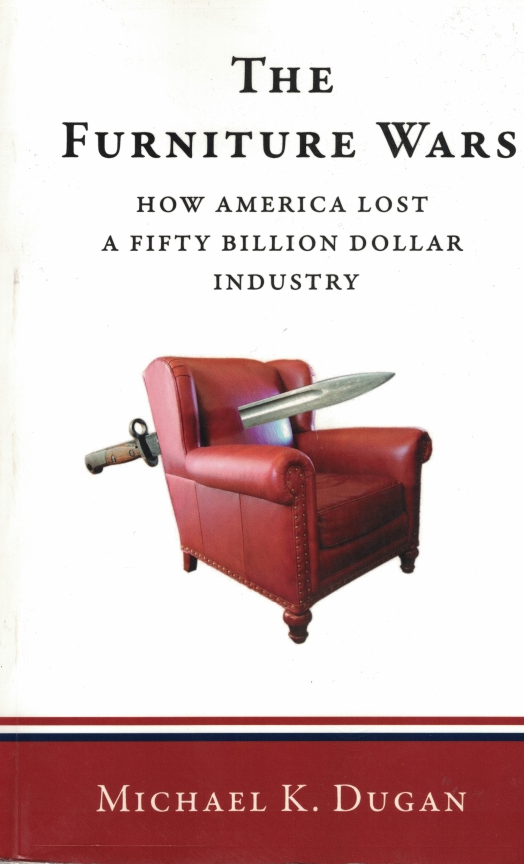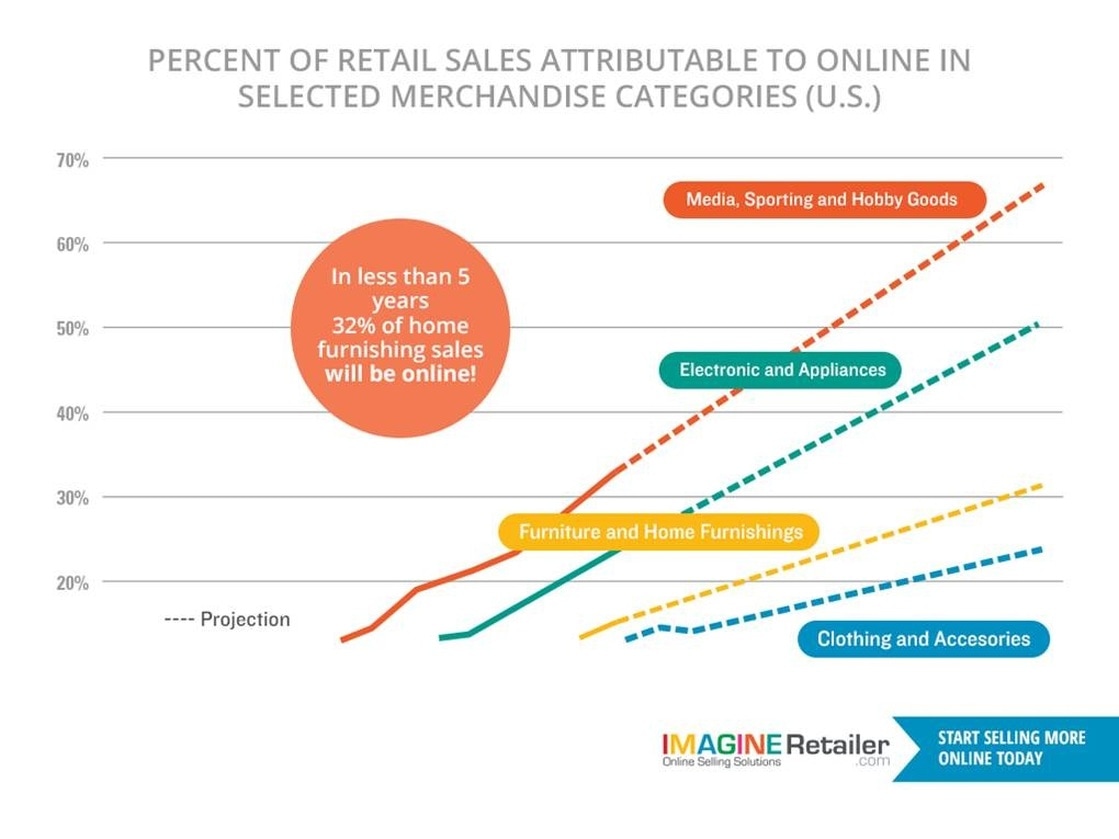THE FURNITURE WARS
HOW WE LOST A $50BN INDUSTRY
by michael dugan
(A MUST READ FOR ANYONE IN THE INDUSTRY)
AND WE'LL CONTINUE TO LOSE IF WE DON'T CHANGE
UPDATED - 12/15/2017
UPDATED - 12/15/2017
I wrote the original post in 2017 and I received over 1,500 page views on this platform and 850+ on my LinkedIn platform. Needless to say, I must have hit home with the original.
I decided to update the original post after I had an email exchange with a peer in the industry where we were discussing e-commerce in the industry based on an article he wrote: http://blueacorn.com/blog/ecommerce-trend-furniture-retail-growth-opportunities . He asked me what I thought and here is what I predicted
I decided to update the original post after I had an email exchange with a peer in the industry where we were discussing e-commerce in the industry based on an article he wrote: http://blueacorn.com/blog/ecommerce-trend-furniture-retail-growth-opportunities . He asked me what I thought and here is what I predicted
I predict that 30% of all furniture sales will be sold online by 2020.
I added a qualifier however that directly related to the original article I wrote on this subject and when I re-read the article, I was amazed at how little or nothing has changed since I wrote it. That's why I think it's worth re-issuing it with some updated information and thoughts for my readers before the upcoming January 2018 Las Vegas Furniture Market
sharing my thoughts and insights about the book and why it matters today
|
|
I wanted to share my thoughts on;
Additional Goals/Objectives Manufacturer Brands, Retailers & Sales Reps Can Accomplish At The January Las Vegas Furniture market My Thoughts About The Book & Why It's Relevant Still Today A VERY good friend of mine gave me this book for Christmas. I read it on the plane traveling to the Vegas Market last January 2016 and I was dumbfounded on what I learned from the history of our industry and how much of the lessons learned back then, have not been embraced today... Yep, history is repeating itself, it's the degree of sophistication that has changed, which will continue to erode this category, and we stand to lose $billions more, very quickly. THE DIFFERENCE NOW IS, THE "OUTSIDERS" BACK THEN FAILED MISERABLY IN TRYING TO TRANSFORM OUR INDUSTRY.
|
AND....
in my opinion, we are repeating those mistakes today, but as INSIDERS...not OUTSIDERS like the book explained and outlined.
As I mentioned above, history too often repeats itself, usually masked in the degree of sophistication as to how it repeats itself, by committing the same stupid mistakes, with different rationale, excuses, or just plain ignorance or arrogance of the facts for whatever reason.
We are facing the "commoditization of everything" in this industry, no brands, limited content for consumers to search/find on retailers & brand websites, messaging that focuses on price and "cheap" and the blatant rejection of new technologies and consumer buying trends in creating sales velocity. These rejections, or refusal to even listen and learn new ways of doing business is mainly because these NEW companies or thought leaders are not "insiders" and are labeled as "outsiders" that "Don't understand "our "business".
These rejections, or refusal to even listen, and learn new ways of doing business, is mainly because these NEW companies or thought leaders, are not "insiders"and are labeled as "outsiders" that Don't Understand "our business".....so we don't even acknowledge they exist or rarely entertain the idea of even "listening" to what they may have to help us sell more.
in my opinion, we are repeating those mistakes today, but as INSIDERS...not OUTSIDERS like the book explained and outlined.
As I mentioned above, history too often repeats itself, usually masked in the degree of sophistication as to how it repeats itself, by committing the same stupid mistakes, with different rationale, excuses, or just plain ignorance or arrogance of the facts for whatever reason.
We are facing the "commoditization of everything" in this industry, no brands, limited content for consumers to search/find on retailers & brand websites, messaging that focuses on price and "cheap" and the blatant rejection of new technologies and consumer buying trends in creating sales velocity. These rejections, or refusal to even listen and learn new ways of doing business is mainly because these NEW companies or thought leaders are not "insiders" and are labeled as "outsiders" that "Don't understand "our "business".
These rejections, or refusal to even listen, and learn new ways of doing business, is mainly because these NEW companies or thought leaders, are not "insiders"and are labeled as "outsiders" that Don't Understand "our business".....so we don't even acknowledge they exist or rarely entertain the idea of even "listening" to what they may have to help us sell more.
|
the walmartization of the furniture category
What's that mean you ask? It's the end result where only a few retailers decide what brands/products they will carry....limiting the amount of manufacturers that can "play in that game".
The result, the "non-players/manufacturers go...bye-bye" because they don't have any retailers...Mom & Pops to sell to because they refused to help their retailers embrace "the new consumer" and what THEY WANT. More on this later...
And for those that do get to play, what happens? They become totally reliant on those few retailers that buy from them, and then those retailers force them to drive down their selling price, so they can sell more at cheaper prices to where a decent profit becomes difficult, or non-existent.
Then they either fail, or re-structure, to try and sell "more retailers", and that's probably the Mom & Pops they ignored in the first place....How much will that cost?
That's the Wal-Mart effect. I know it, I worked for a company that failed because of that "sell the big boys only" strategy, and that's exactly what I warned them would happen...and it did!
WHY IS IT we are failing YOU ASK?
Because it wasn't invented HERE...I mean all of these new ideas, way to show, tell and sell our products, new strategies and tactics and the technologies are coming from outsiders...
The result, the "non-players/manufacturers go...bye-bye" because they don't have any retailers...Mom & Pops to sell to because they refused to help their retailers embrace "the new consumer" and what THEY WANT. More on this later...
And for those that do get to play, what happens? They become totally reliant on those few retailers that buy from them, and then those retailers force them to drive down their selling price, so they can sell more at cheaper prices to where a decent profit becomes difficult, or non-existent.
Then they either fail, or re-structure, to try and sell "more retailers", and that's probably the Mom & Pops they ignored in the first place....How much will that cost?
That's the Wal-Mart effect. I know it, I worked for a company that failed because of that "sell the big boys only" strategy, and that's exactly what I warned them would happen...and it did!
WHY IS IT we are failing YOU ASK?
Because it wasn't invented HERE...I mean all of these new ideas, way to show, tell and sell our products, new strategies and tactics and the technologies are coming from outsiders...
the super regional effect
We have super-regional store chains financed by outside Money Funds that are permeating every major market very rapidly, displacing mom-pop local retailers and growing at double digits. For Example
Art Van - since it was purchased by Thomas H. Lee Partners, has expanded it's franchise to 117 stores in Michigan, Illinois, Ohio, Indiana and Iowa. Recently they purchased Levin's Furniture & Wolf Furniture, expanding their presence in Pennsylvania and Ohio. They are now a 10 national retailer with 176 stores that include 18 Art Van franchise stores in nine states and $1.3 billion in expected 2018 annual sales.
Bob's Furniture was purchased by Bain Capitol in 2013 and since that time, they expanded dramatically on the East Coast, Midwest and now the Los Angeles market. They finished the year with 76 stores in 15 Northeast, Mid-Atlantic and Midwest states and estimated furniture, bedding and accessory sales of $1.16 billion.
These are just two examples. I expect a flood of acquisitions, mergers and more as we witness:
Art Van - since it was purchased by Thomas H. Lee Partners, has expanded it's franchise to 117 stores in Michigan, Illinois, Ohio, Indiana and Iowa. Recently they purchased Levin's Furniture & Wolf Furniture, expanding their presence in Pennsylvania and Ohio. They are now a 10 national retailer with 176 stores that include 18 Art Van franchise stores in nine states and $1.3 billion in expected 2018 annual sales.
Bob's Furniture was purchased by Bain Capitol in 2013 and since that time, they expanded dramatically on the East Coast, Midwest and now the Los Angeles market. They finished the year with 76 stores in 15 Northeast, Mid-Atlantic and Midwest states and estimated furniture, bedding and accessory sales of $1.16 billion.
These are just two examples. I expect a flood of acquisitions, mergers and more as we witness:
They are growing because they have "adopted outsiders" technologies, knowledge systems and processes at the expense of those retailers that haven't. Sure they have the economy of scale, but so does the smaller and medium sized retailer...they just don't research it or refuse to embrace it .... so the saga continues. They grow and you don't!
The argument against what I'm talking about is that the furniture category is growing ... and it is, BUT what concerns me is how it's growing. When you have a few "super regionals" gobbling up the market share, here's what happens:
CHOICES
The argument against what I'm talking about is that the furniture category is growing ... and it is, BUT what concerns me is how it's growing. When you have a few "super regionals" gobbling up the market share, here's what happens:
CHOICES
- The larger super-regionals have the resources to contract with overseas factories and bring in their own goods. This hurts domestic factories and U.S. jobs. We have lost over 270,000 U.S. furniture jobs since 2000 and this will only help continue this slide downward.
- This economy of scale creates a "sameness" on the retailer's floor. Think Macy's when they bought out all those regional department stores and centralized buying. It worked great for a few years, but what played in NYC, didn't play in Peoria.
- The local economy loses too. Sure they create jobs, but ultimately the profits head back to their headquarters and the state they are headquartered in
ignoring the impact of a great website and E-COMMERCE
Why is it....that so many brands and retailers ignore new opportunities/platforms to educate, motivate and engage consumers that "want to" engage with them ... see all the products they have on their website with the goal of a visit to their store...LOCALLY,
Let's talk about THE FIRST MOMENT OF TRUTH in the sales journey. YOUR WEBSITE.
Why is it that most retailers do NOT invest in their website when 80%+ of all searches for furniture begin on the web. I think that 30% of all retailers in this category either don't have a website, or if they do it has only a landing page. I've heard that virtually every retailer thinks that $399.00/month+ is too expensive and anything over $699.00 is absurd.
Why is it that most retailers do NOT invest in their website when 80%+ of all searches for furniture begin on the web. I think that 30% of all retailers in this category either don't have a website, or if they do it has only a landing page. I've heard that virtually every retailer thinks that $399.00/month+ is too expensive and anything over $699.00 is absurd.
- We STILL ignore the investments necessary to attract consumers with a decent website loaded with thousands of SKU's....when the FACTS show over 80% of people searching for furniture START ON THE INTERNET and over 76% of them are looking for product information on YOUR WEBSITE. AND over 75% of consumers will check your website out when they see an ad for your company. $699/mth is too expensive...REALLY ??? I suppose that remaining 20% of consumers that may not use the website are making your business rock, right...I bet NOT.
- Amazon has 5.5MM pages of furniture SKU's, Wayfair has 35,000,000 pages, do I need to mention others like OverStock, etc? Get the message...SHOW MORE...SELL MORE, or better yet, do nothing and enrich them at your expense or wait for the super-regionals to come in and show you how to do it!
- We ignore putting every SKU we have open to buy on our website, because "We don't want to do Special Order"...even though EVERY online retailer's purchase IS A SPECIAL ORDER"!
- Some still ignore the need to have a website MOBILE RESPONSIVE, when it's a fact that over 200 million consumers have Smartphones and tablets...and guess what...they aren't making a ton of phone calls, they are surfing the internet, interacting with websites, watching videos, reading reviews and maybe/hopefully they are spying on your store?
- We ignore putting prices or having e-commerce on our websites, even though MasterCard & The Wall Street Journal reported holiday sales of furniture grew HUGE double digits and that it's predicted by 2020, 32% of ALL furniture purchases will be on-line
Shoppers on Wayfair websites purchased a sofa every 13 seconds Cyber Monday; a mattress every eight seconds, and a rug every two seconds, and those purchases helped create what is now the best sales day in the company’s history, eclipsing Black Friday.And guess what - EVERYTHING they sell is special order ... AND they have tons of SKU's. I'll bet that because you don't have those 100K SKU's that any local search in your area for a product diverts to Wayfair, Amazon or other e-commerce website that does
|
projected online sales 2020 |
Christmas Season U.S. E-commerce Sales Rose Roughly 20% Year Over Year Between Black Friday And Christmas Eve,
Says Mastercard Spendingpulse. Among The Strongest Overall Categories Was Furniture, Which Saw Double-digit Growth.
Perhaps More Noteworthy Is That Furniture—once Thought Of As Confined To Brick-and-mortar Stores—also Was One Of The Fastest-growing Categories Online. |
technology investments - or lack of will kill your business rapidly
using the available technology our industry offers can level the playing field
What I have learned, through experience, is that there are two primary barriers of entry for new technologies, and it's all based off yesterday's linear thinking;
- First, people don’t want to invest in it ... IT'S TOO EXPENSIVE ....they prefer the analog way of doing business vs. embracing the new digital world. When I say invest, most of these solutions are less than $100/mth, the cost of lunch for four in a decent restaurant. Instead they'll wait to invest in the technologies to sell more when they advertise their "Going Out Of Business Sale", why? Because it will work to get rid of their stuff, quickly and efficiently! Think about that for a minute.
- Second, and the most disturbing, relates to the fact that many of the I.T. people, or people that may run/manage your website refuse or resist to integrate new technologies into your business platform even if they’ve been proven to enhance your marketing strategies, sales lift, and profitability. I can't understand this. You as a brand or retailer know your business, what works and what doesn't. Why would you let an outsider control what you want and what you know?








